Shade Trees
Shade trees are a great way to keep your property cool during the summer and save on utility costs. Plus, they’re beautiful!
With our best-sellers on top:
- Red Oak:
50’-60’ tall, 40’-60’ wide
This deciduous shade tree is widely adapted over the entire state. Tolerant of alkaline soil and is less subject to iron chlorosis. The foliage is dark green in summer turning brilliant red to yellow in the fall. Has a moderate growth rate and is one of the finest shade trees for Texas gardens. - Chinese Pistache:
40’-70’ tall, 50’-70’ wide
Chinese Pistache grows quickly in full sun in moderately fertile, well-drained soil and will withstand heat and drought extremely well. The crown is quite round and symmetrical on older trees. Grows in clay, loam or sand in a wide range of soil pH. Fall color ranges from yellow to red and deep maroon. Female trees have small red fruit in late summer into the fall - Lacebark Elm:
40'-60' tall, 30'-50' wide
This rounded tree has delicate foliage that turns bright yellow in the fall and the bark is mottled gray-brown in older trees. Drought-tolerant and widely adapted to a range of soils, this a fine landscape tree. - Live Oak:
50’ tall, 60’ wide
This Texas native evergreen tree has a moderately slow growth rate and is relatively drought tolerant. These trees will turn over their leaves through the late winter followed by new growth in Spring. A long-lived tree that is one of the best for shade and grows in any soil. - Bald Cypress:
60’-70’ tall, 30’-45’
This fast-growing tree is widely adapted to much of the state, although it may show iron deficiency in extremely alkaline soil. The foliage is light green, fine and fern-like and may shed in a drought. Can be planted in a wide range of soils as well as waterlogged soil. Fall color is coppery bronze to dark rust-red. - Autumn Blaze Maple:
30’-40’ tall, 20’-25’ wide
One of the best compact maple trees, the Summer Red Maple puts on a brilliant fall show of bright red. This maple is well-adapted to our hot summers but may need supplemental watering during summer droughts even when mature. - Frontier Elm:
25’-50’ tall, 15’-30’ wide
This tree is small to intermediate sized, single-trunked, upright-pyramidal deciduous tree. Faster growing than other elms, it grows at a medium-to-fast rate depending on moisture and fertility levels. Very easy to grow, adapts to most conditions. - Cedar Elm: 40'-60' Tall 30'-50' Wide. Nicely proportioned hardy shade tree tolerant of a broad range of soil types. Foliage may turn yellow in the Fall.
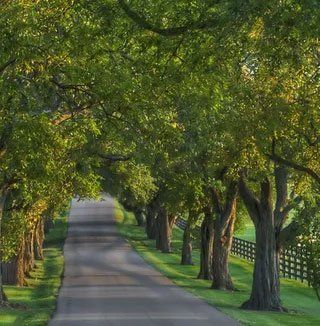
Ornamental Trees
Ornamental trees are typically smaller than a normal shade tree and usually flower and/or have unique foliage. Ornamental trees are a great way to add height, color and texture to your beds. They range widely in needs so it is best to do some research or come in with the specifications of your spot so we can help you choose the right tree for your spot. Varieties may vary from year to year.
- Cedar - evergreen; good for privacy
- Brodie Cedar
- Eastern Red Cedar - Chitalpa - water efficient
- Crepe Myrtle - water-efficient; summer color
- Acoma - dwarf white
- Arapaho - pinkish red
- Centennial Spirit - pinkish red
- Dallas Red - pinkish red
- Delta Flame - dwarf, dark purple leaves, red flowers
- Dynamite Red - dark red
- Ebony Flame - dwarf, dark purple leaves, red flowers
- Natchez - white
- Pink Lace - dwarf, pale pink flowers
- Red Rocket - true red
- Sioux - light pink
- Tonto - pinkish red
- Tuscarora - bubblegum pink
- Zuni - lavender - Cypress - evergreen
- Arizona Cypress "Blue Ice" - frosty foliage, water-efficient
- Carolina Sapphire Cypress - frosty foliage - Desert Willow - water-efficient; long-lasting trumpet flowers
- Dogwood - needs shade from afternoon sun; prefers acidic soil
- Rough leaf: 8'-15' Tall Texas Native species that blooms tiny yellow/white flowers that bloom in the Spring. Fruits attract birds. Adaptable and can grow in full sun to part shade. - Eve’s Necklace - native; cascading flowers; black seed pods
- Japanese Maple - needs shade from afternoon sun, prefers sandy soil
- Bloodgood - burgundy foliage
- Coral Bark - striking red bark in fall and winter
- Crimson Queen - dwarf; weeping; crimson foliage
- Tamukeyama - dwarf; weeping - Juniper - evergreen; good for privacy or framing an entryway, water efficient
- Blue Point Juniper
- Hollywood
- Spartan Juniper
- Taylor's Juniper
- Ornamental Plum - adds color
- Flowering Plum ‘Krauter Vesuvius’
- Mexican Plum - water efficient - Redbud - some native varieties, water efficient
- Eastern - native
- Forest Pansy - purplish foliage
- Merlot - purplish foliage
- Oklahoma - glossy foliage; dark purple blooms
- Rising Sun - apricot foliage in early spring
- Ruby Falls - weeping
- Travelers - weeping - Texas Mountain Laurel - evergreen; fragrant, cascading flowers; water-efficient
- Vitex - water efficient
- Weeping Willow - prefers waterlogged soils
We pride ourselves on stocking unique plants; if there is something specific you are looking for that is not listed, call us or come in.
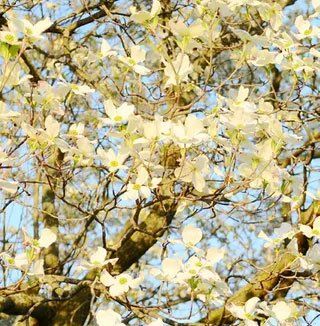
Fruit & Pecan Trees
There are many varieties of fruit trees that are well-adapted to our climate and soil conditions. Fruit trees are a great way to add function to your landscape. When choosing a fruit tree from our selection, the most important factor to consider is what you like to eat.
Most fruit trees require over six hours of sunlight and soil with good drainage in order to thrive. Amending heavy clay soil with compost before planting is important. Planting in a raised bed will be beneficial in providing drainage in heavy clay soils.
Our fruit trees usually come in 5-gallon buckets, with a few exceptions.
Below are the fruit tree varieties that are well-suited for the area that we carry at Meador's Garden Center & Landscaping and some general information about each. It is important to note that the varieties listed will not always be in stock and it is best to call or come in to see what we have.
Apricot Trees
- Moorpark:
late bearing (mid-June to early July); self-fertile
- This tree produces large oval fruit that has excellent flavor for preserves and pies. This self-fertile tree is a good pollinizer for late varieties, like tilton. Moorpark is a beautiful tree for the landscape that will bear heavily. Plant in well-drained healthy soil and avoid planting in low, sheltered sites. Will produce by the fifth year. - Early Golden:
late bearing (early July-early Aug); self-fertile
- This tree produces large, flavorful, golden apricots with a sweet, rich flavor. A landscape tree with attractive leaves and pink or white flowers. Self-fertile but planting two varieties is recommended for a better crop. This fast-growing tree grows in sandy, well-drained soils. This tree requires moist, well-drained soil and is not drought tolerant. - Royal:
late bearing (August) self-fertile
- This self-fertile tree produces medium to large fruit that is juicy and firm with a delicious flavor. Good apricot for canning and drying. Best planted in healthy well-drained soil.
Nectarine Trees
- Smooth Texas One:
mid-May to early to mid-June
- This new nectarine cultivar would supply a nectarine fruit over 3-4 weeks from mid-May until early to mid-June. This nectarine has medium to large fruits with yellow flesh that is melting and firm. Productivity is high. Requires 550-600 chilling hours. - Surecrop:
late bearing (mid-Aug); self-fertile
- Surecrop is a vigorous, productive nectarine variety. Has attractive skin that is lush red over orange. A freestone variety, self-pollinating and fuzz-free. A fast-growing ornamental beauty, the nectarine attracts hummingbirds in the spring with its profuse pink flowers. Great for a small space in well-drained soil and full sun.
We pride ourselves on stocking unique plants; if there is something specific you are looking for that is not listed, call us or come in.
Note:
- Soil conditions and weather patterns may affect the size of your crop.
- The varieties listed will not always be in stock and it is best to call or come in to see what we have.
Apple Trees
- Mollie’s Delicious:
early bearing (late July- mid-August); needs pollinizer
- Mollie’s are large to very large conical shaped fruit with yellow flesh and up to 50% red blushing skin. Fruit is sweet, flavorful and very aromatic. Mollie’s delicious is an early-blooming variety that will pollinate all other early blooming varieties and those with mid-season bloom time. This apple is highly recommended for southern locations - Red Delicious:
late bearing (late Sept-Oct); needs pollinizer
- This vigorous tree produces a beautiful and large, crispy apple and requires a pollinizer (Yellow delicious is suggested.) to bear more heavily. Good pollinizer for almost all other apples. Best if planted in well-drained healthy soil. Fertilize in late winter with a high-phosphorus fertilizer just before the buds are out. Avoid heavy one-time feeding. - Yellow Delicious:
late bearing (late Sept-Oct); somewhat self-fertile
- This self-fertile tree produces large, crisp apples that have a golden yellow skin. A favorite apple that has outstanding flavor as well as a good pollinator. Plant in well-drained healthy soil. Fertilize in late winter with a high-phosphorus fertilizer just before the buds are out. Avoid heavy one-time feeding.
Note:
- Soil conditions and weather patterns may affect the size of your crop.
- The varieties listed will not always be in stock and it is best to call or come in to see what we have.
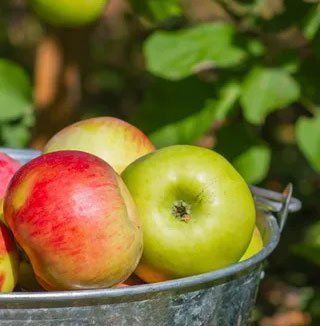
Citrus
Lemon, lime
and orange
trees will need to be taken indoors to survive our winters.
Note:
- Soil conditions and weather patterns may affect the size of your crop.
- The varieties listed will not always be in stock and it is best to call or come in to see what we have.
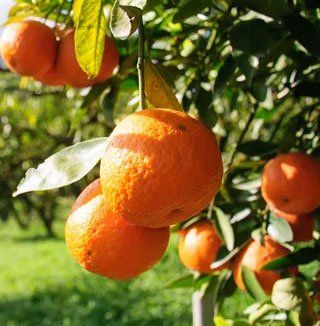
Fig
All fig varieties we carry are self-fertile.
- Celeste:
early bearing (mid-June); cold hardy
- The Celeste fig is small, brown to purple colored, and adapted to all areas of Texas. Celeste is the most cold-hardy of all Texas fig varieties. The tree is large, vigorous, and very productive. Ripens in mid-June before the main crop of other Texas fig varieties. Celeste has excellent fresh dessert quality with a rich sweet flavor. Do not prune mature Celeste trees heavily since this can reduce the crop. - Brown Turkey Fig:
mid-season bearing (late June)
- This variety has the longest ripening season of the recommended varieties. Not quite as cold hardy, injured by a freeze. Produces fair-to-good crops. The fruit is medium to large, with a reddish-brown skin tinged with purple. The pulp is reddish-pink and is excellent for making home preserves. Sunlight is key to maximizing fruit production. - Texas Everbearing:
late bearing (July-Aug)
- This self-fertile tree produces medium to large fruit that is bell-shaped with amber flesh. Produces young and gives a good crop in short-season areas. Tolerant of cold weather and a wide range of soils, but it does best in healthy soil. Needs plenty of water as well as heavy mulching. Requires little if no fertilizer. Prune only old deadwood if needed.
We pride ourselves on stocking unique plants; if there is something specific you are looking for that is not listed, call us or come in.
Note:
- Soil conditions and weather patterns may affect the size of your crop.
- The varieties listed will not always be in stock and it is best to call or come in to see what we have.
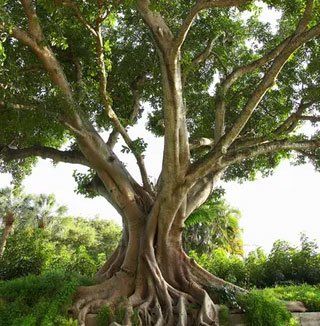
Peach
All peach varieties we carry are self-fertile.
- Elberta:
late bearing (late July to early Aug)
- This self-fertile tree produces large, sweet fruit with a yellow flesh that can be used for all purposes. Harvest when the fruit is slightly soft to the touch. Freestone. Peaches are very susceptible to waterlogged soils, so good to excellent internal soil drainage is essential to long-term tree survival. The ideal is a sandy loam topsoil. - Goldenzest:
early bearing (mid-May to late July)
- This new peach cultivar would supply a series of peaches over five weeks from mid-May until late July. Peaches are firm, attractive, yellow-fleshed, and high quality These peaches need between 500 and 600 chilling units. - Harvester:
early bearing (late June)
- This dwarf peach tree won't take up lots of room in your yard, so you'll be able to enjoy one even in a small space. Blooms fragrant pink and white blooms in early spring and, by early, fall produces large yellow and blush-colored peaches even at a young age. Highly tolerant of heat and humidity. Self-pollinating, but will produce more with another peach. - Loring:
late bearing (mid-Aug)
- This vigorous tree is early-blooming and produces very delicious yellow-fleshed, freestone peaches that are considered by many "the best tasting peach." The fruit can be used for table-eating or in preserves. First harvest can be expected after the third season, with peak production after seven. Requires rich, well-drained soil. - Ranger:
mid-season bearing (late July)
- One of the best late-blooming/frost hardy peaches for cold climates. Medium size, full-flavored, high-quality yellow freestone. At 3 or 4 years of age they begin to bear large crops and reach peak productivity at 8 to 12 years. Very susceptible to waterlogged soils, so good soil drainage is essential. The ideal soil is a sandy loam topsoil. - Red Globe:
late bearing (August)
- Red globes have a bright red skin color and can be used for baking or canning. This tree is productive, but the buds can be susceptible to early frosts. Freestone. Plant in well-drained sandy soil. - Redskin:
late bearing (early Aug)
- A cross between J.H. Hale and Elberta. Redskin has excellent qualities for fresh eating, shipping, canning or freezing. This freestone peach has large, firm, yellow flesh with velvety, deep red blush on skin, 750 chill hours. Tree is vigorous and productive.

Pear
- Kieffer:
mid-season bearing (late Sept-Oct); somewhat self-fertile
- This medium-to-large rich-yellow pear is rather coarse and hard, it is preferable for pear preserves, and freshly cooked pear sauce. Fruit should be picked hard-ripe and allowed to reach its flavor peak stored in a cool place. Easy to grow, and adapt to most conditions. Heavy bearer that is highly resistant to fire blight. - Moonglow:
early bearing (August); needs pollinizer
Moonglow produces large, soft, and juicy Bartlett-type pears with brownish-green skin and no gritty texture. Very resistant to fire blight. Moonglow have a short shelf life so much better for the home garden than commercial production. Requires a pollinator for best production. (500 chill hours)
We pride ourselves on stocking unique plants; if there is something specific you are looking for that is not listed, call us or come in.
Note:
- Soil conditions and weather patterns may affect the size of your crop.
- The varieties listed will not always be in stock and it is best to call or come in to see what we have.
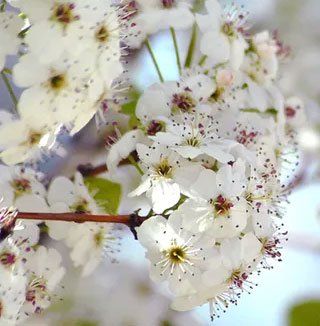
Pecan
- Burkett: One of the first papershell varieties. Late-pollinating. Burkett is a medium to large nearly perfectly round soft shell nuts. It is rich, with a distinctive flavored kernel. It is a large tree and ripens in late September and through early November. Likes arid climates.
- Desirable: These trees feature medium-large soft-shelled pecans that are a very productive. A consistent bearer and are noted for their good eating quality. Develops quickly and is one of the best pollinators for other cultivars. Ripens in mid-October. The planting site should have good drainage, receive full sun and be at least 30 feet from a building and other trees.
- Pawnee: The nuts of the Pawnee pecan tree are large with a thin shell, somewhat elongated. Disease resistant and produces heavy crops of large, well-filled nuts. The Pawnee pecan tree is an excellent choice for people with limited space due to its relatively small size. More resistant to cold and can harvest earlier in the year than many other pecan cultivars.
- Stuart: The trees are strong and upright, requiring less training and pruning compared to other cultivars. Stuart pecan trees are a late-season pollinator, which is recommended to be planted with an early-season pollinator. Nuts of the Stuart pecan Trees are medium-sized, with a thicker shell than some of the other paper shell pecan varieties.
- Mohawk: This vigorous tree produces thin shelled nuts. It is self-fertile, however, it does better with a pollinator. Bares heavily. Good choice for planting in well-drained soil.
Note:
- Soil conditions and weather patterns may affect the size of your crop.
- The varieties listed will not always be in stock and it is best to call or come in to see what we have.
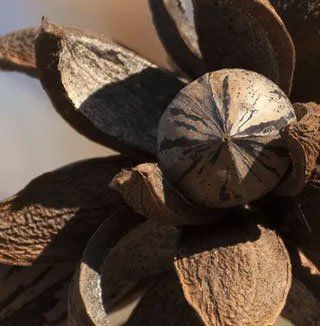
Pomegranates
Pomegranates
- Wonderful:
mid-season bearing (Sept-Oct); self-fertile
- This deciduous shrub blooms showy red-orange flowers in the summer followed by extra-large purple-red fruit. Quite tolerant of a wide range of soils as well as heat. Foliage is glossy green with bronze new growth and bright yellow fall color. This long-lived shrub is drought tolerant.
Persimmons
All persimmon varieties we carry are self-fertile.
- Eureka: early bearing (October)
- This vigorous tree produces large, tomato-shaped fruit that is bright red-orange. The seedless fruit from this tree will be often sour until after the first frost. Eat immediately because persimmons don't store well. Easy to grow in almost any soil, but does the best in moist but well-drained soil. - Fuyu Japanese: mid-season bearing (late October to December)
- This popular tree produces a medium-sized flattened red fruit that is sweet even when eaten at the green stage. The bright orange color begins to develop in late October and the fruit will remain delicious even into the month of December. Plant in deep, well-drained soil. Self-fertile and can be used to pollinate all other varieties.
We pride ourselves on stocking unique plants; if there is something specific you are looking for that is not listed, call us or come in.
Note:
- Soil conditions and weather patterns may affect the size of your crop.
- The varieties listed will not always be in stock and it is best to call or come in to see what we have.
Plums
- Bruce:
semi-dwarf; mid-season bearing (late May-June); requires Methley as pollinizer
- The Bruce plum tree is a medium-sized tree, produces large amounts of brilliant wine-red fruits, large in size and excellent for canning. One of the toughest plum trees as well as a frost-hardy tree, ideal for low areas. Semi-dwarf, weeping habit. Requires variety Methley as pollinator. Ripens late May-June. Prune in mid to late winter. - Methley:
mid-season bearing (early June); self-fertile
- This self-fertile tree produces medium to large fruit that has an amber flesh that is delicious. The fruit ripens in early June and you can harvest when they are slightly soft and deep in color. One of the easier to grow fruit trees-except in white rock. Tolerant of many soils but well-drained soil is essential. Prune mid- to late-winter. - Santa Rosa:
mid-season bearing (mid-June); self-fertile
- This self-fertile tree produces fruit that is large and oval with a purplish-red skin. Has a firm flesh that rich and pleasing with a tart flavor. One of the easier fruit trees to grow in our area, except in white rock. Normally will start to produce in 3-5 years.
- Soil conditions and weather patterns may affect the size of your crop.
- The varieties listed will not always be in stock and it is best to call or come in to see what we have.
Additional Information
Pollinizers
In the context of fruit trees, a pollinizer is a neighboring fruit tree of the same species but of a different variety that provides the pollen needed for the tree to bear fruit. Many fruit tree varieties have been bred to be self-fertile in recent years.
However, even if the tree variety is self-fertile, having another tree of the same family is helpful in maximizing yield as long as they bloom simultaneously.
Pruning
Most fruit trees will require pruning of some kind before they bud out in Spring, and many varieties will require more pruning than feels comfortable. However, pruning is suggested for maintaining a healthy, productive tree and promoting long-term growth.
Depending on the tree, there are varying methods to get three basic tree structures: the central leader system, the open center system, and natural.
- For pears and persimmon trees use the Central Leader System.
- For apricot, peach, nectarine, persimmon, and plum trees use the Open Center System.
- Keep fig and pomegranate trees natural with some light maintenance (removing dead limbs).
Note: Many growers recommend pruning a newly planted tree by at least one third in order to refocus the plant’s energy into its roots. This will forego short-term rewards (i.e. fruit the first year) for long-term productivity.
Fertilization
Root stimulator is the only fertilizer we would recommend during the fruit tree’s first year of growth. This may be applied at any time.
The ideal time to fertilize fruit trees is up to a month before bud break or just before spring. If the ideal time is missed, fertilizer can be applied until June.
Resources
Each fruit tree requires slightly different maintenance so it would be helpful to use the abundance of information on pruning fruit trees available online. Some sources include:
- https://aggie-horticulture.tamu.edu/fruit-nut/ is a comprehensive compilation of fruit and nut tree care for Texas gardeners.
Other Fruiting Plant Varieties
- Blackberries ripen in the late Spring and like well-drained soil. We carry thornless and traditional varieties including Arapaho, Brazos, Natchez, Navajo, and Roseborough.
- Blueberries ripen in the late spring and appreciate well-drained, acidic soil and rainwater. We carry Climax, Tifblue, and Woodard varieties.
- Grapes ripen in late summer to fall and prefer soils that do not stay extremely wet or dry. We carry a wide range of varieties including Champanel, Concord, Mars, Muscadine, Red Flame Seedless, and 9110 Seibel.
- Raspberries ripen in the late spring to summer. We carry Dorman Red.
We pride ourselves on stocking unique plants; if there is something specific you are looking for that is not listed, call us or come in.
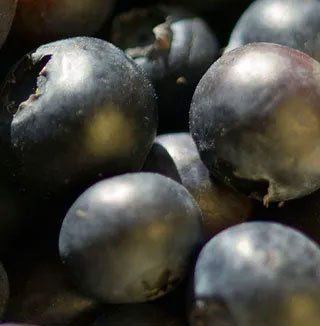
Tree Planting and Care
The soil and weather conditions in North Texas require us to be thoughtful in our approach of planting and caring for our young trees. If you are new to planting and caring for trees, it is a good idea to read through this section before planting.
Planting Recommendations
- Find the right tree for your location.
a. Consider:
i. Amount of sun/shade the area gets
ii. Amount of space available
iii. Soil type - Water your tree before planting.
a. Planting a dry tree can result in damage to the root ball or death. - Dig a hole just wide enough for your tree’s root ball and 1-2 inches shallower than the root ball.
- Set your tree in the hole and fill with a mixture of your native soil (what you removed from hole) and compost.
- Pack soil in and water well.
a. Avoid putting soil on top of the root ball once planted. This could result in your tree being smothered.
Optional:
- Water with root stimulator.
- Surround tree with a 3-inch layer of mulch (taking care that the mulch does not touch your tree; the mulch should surround your tree in a mound, like a donut) to regulate temperature and moisture.
- Wrap the tree with tree wrap to prevent sunscald.
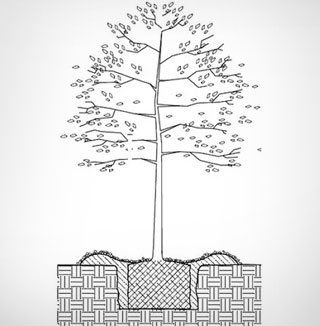
Watering Recommendations
How do I water my new tree? Can I use my sprinkler system?
We do not recommend using a sprinkler system unless you have a bubbler attachment, as the water does not get deep enough to reach the root zone. The best way to water a new tree is with the slow trickle of a hose or a soaker hose. This ensures that the water gets to the deepest part of the root ball without running off. A good soaking rain will do the trick too!
How often?
The following is a good schedule to follow based on average weekly temperature:
- 60°F: once every 2 weeks
- 70°F: once every 10 days
- 80°F: once every 7 days
- 90°F and above: twice every 7 days
A good, soaking rain will replace one watering.
During the winter, water once every 2-3 weeks.
How long do I water?
It depends on the size of the tree/root ball. Here is a guide, but please remember, your intuition and your finger are the best judges.
With your hose at a slow trickle:
- 7 gal: 10-15 minutes
- 10-15 gal: 15-30 minutes
- 30-45 gal: 30 minutes-1 hour
General Maintenance
Staking
We usually do not recommend staking the tree as the stakes limit movement and can cause the tree to become dependent on them for stability.
If it is determined that your tree needs to be staked, remove stakes after one year.
Observation
Several years of its growth is imperative to its survival. Insects and disease can be harmful to the growth of a tree.
If you experience a problem with your tree in the first year, it is most likely a watering issue.
Clues that your tree is experiencing stress may include:
- Leaf drop (outside of fall)
- Coloration changes (outside of fall)
- Dieback
- Holes in trunk
If your tree experiences these changes, the Internet can be a wonderful tool. We’d also be happy to help. Email pictures to meadornursery@msn.com
and/or bring in cuttings of your tree, so we can help you determine what may be the problem and how to fix it.
Fertilization
We recommend that you avoid using most fertilizers for the tree’s first year of growth because they mostly promote top growth. While the tree is young, establishing a hardy root system is more important than a fuller tree.
Root stimulator for the tree’s first year of establishment is a good option for promoting long-term health and can be applied at any time.
Dressing
Spring and fall are the best times to add a new top dressing around the tree. This can be done with compost and/or mulch. Compost will add nutrients, and mulch will help regulate temperature and moisture and as well as add additional nutrients. Make sure the depth of the mulch is no more or less than three inches.


Share On: